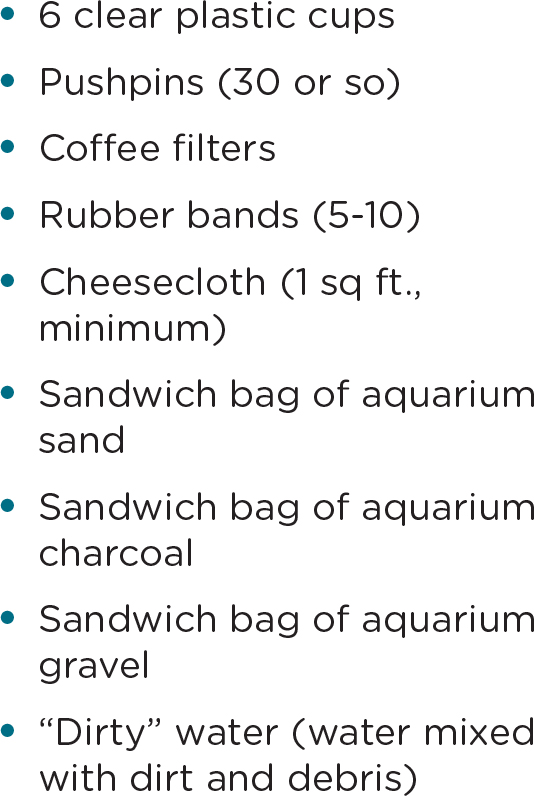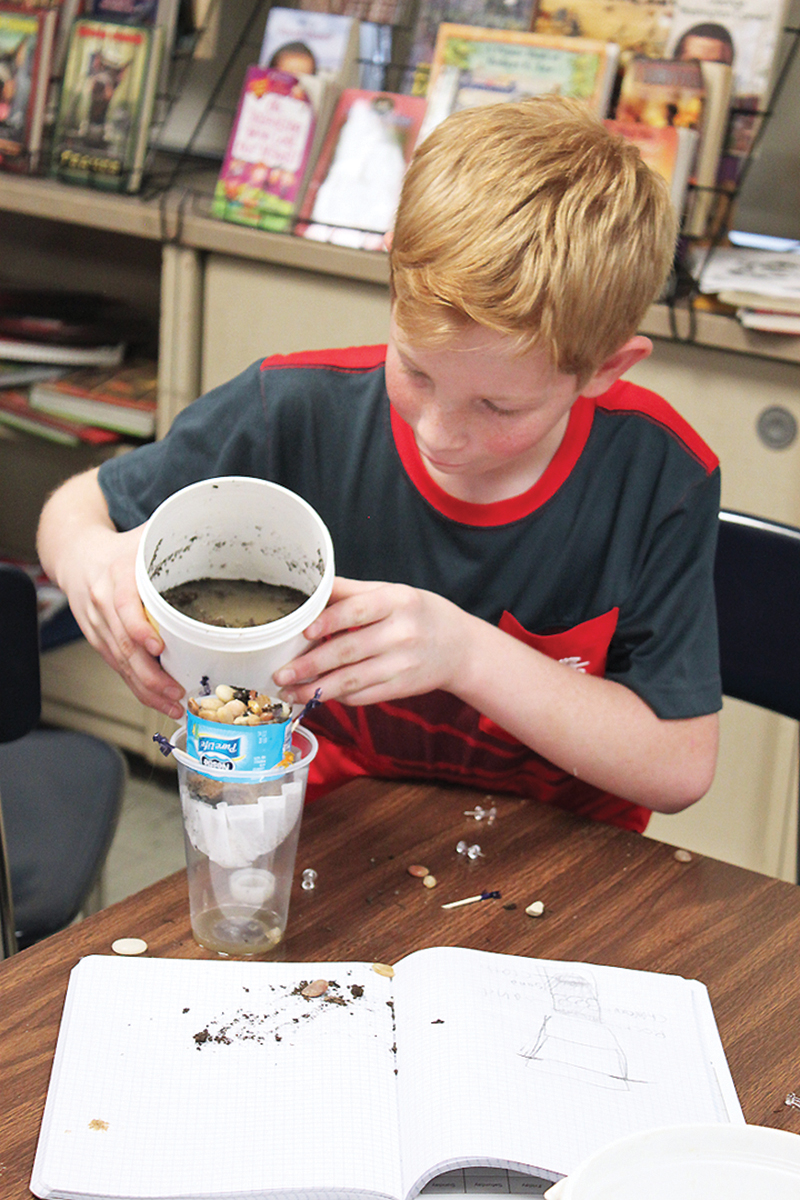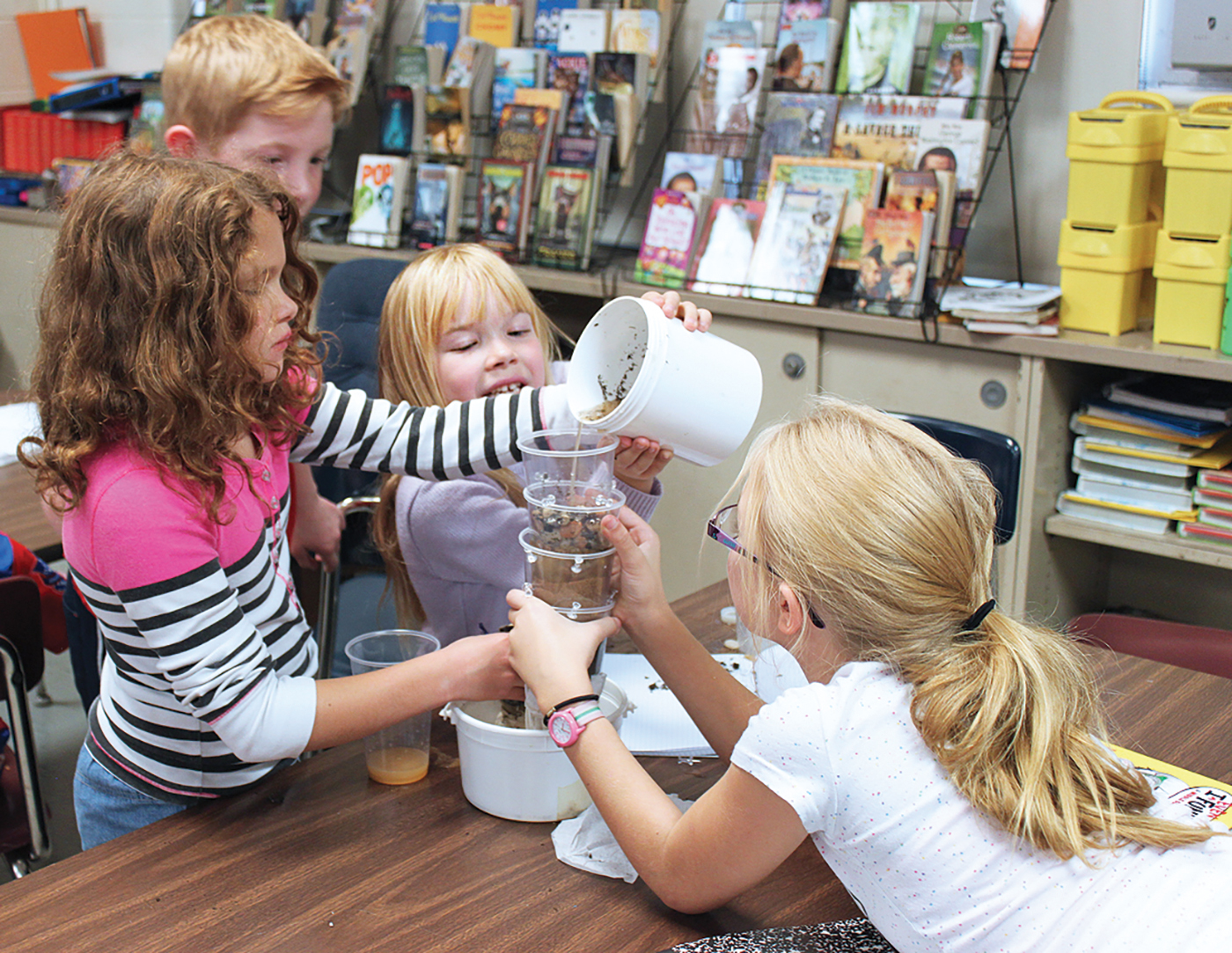Engineering Encounters
Engineering a Model of the Earth as a Water Filter
Engineering a Model of the Earth as a Water Filter
By Jonathon Kilpatrick, Nanette Marcum-Dietrich, John Wallace, and Carolyn Staudt
Teaching students about the water cycle is a staple of elementary science instruction. When asked to describe the water cycle, most students can quickly recite the continual cyclical process of condensation, precipitation, and evaporation. But this simple definition misses the essential process of infiltration. Groundwater and the process of infiltration, which cleans that water, are vital to our survival, but they are also hidden from view and too often absent from our science curriculum.
Infiltration is the process by which water is naturally filtered by the Earth. Rain falls on the Earth’s surface and seeps into the ground. The type of soil particles and vegetation covering the soil influences infiltration rate. Soil pores exist between particle types and are occupied by water and air. Some of this water soaks deeper into the ground through layers of humus (organic debris such as twigs and leaves), surface soil, subsoil, gravel, sand, and other particles, creating a macropore filtration system and joining the groundwater storage areas called aquifers that are important resources for drinking water.
An amazing thing happens as this water travels through the layers of the Earth. During its travels, it is cleaned. In fact, it is this macropore filtration that aids the cleansing process by trapping “dirty” particles in the pores between different soil types. According to the Environmental Protection Agency (EPA), “About half of our nation’s drinking water comes from groundwater. Most is supplied through public drinking water systems. But over 15 million families rely on private, household wells and use groundwater as their source of fresh water” (EPA 2016). Noting the importance of infiltration in the water cycle and in the supply of essential groundwater led us to develop an engineering activity in which students are challenged to build a stackable filter using the Earth process of infiltration as a model.
Water Filtration Activity
On a sunny summer afternoon, our team of teacher researchers met with a small group of students and a pile of materials (Figure 1). During one of the activities, students were presented with a large pitcher of “gross” (as they described it) water full of dirt and debris found outside. Make sure students properly wash hands after working with soil.

Students were asked, “Can you filter water?” Students were instructed how to build a stackable filter with cups and pushpins. They were then left to their own creativity. Using the cups and pushpins plus sand, charcoal, cheesecloth, gravel, and rubber bands, they experimented until they found what they considered to be the best possible way to filter the water. “What if we pour the water through the gravel first to catch the big stuff, then the charcoal, then the sand? That would work the best because it would catch smaller pieces lower down,” offered one student. Another replied, “A lot of sand is mixing with the water though, and now it looks really dirty. Maybe sand should go first.” These conversations continued throughout the design process.
By the end of the session, the students had constructed three filters. Two of them were stackable filters with the water passing in turn through different layers and materials. The third was a single cup with all of the materials mixed together. When the filters were tested, all of them filtered the water remarkably well. There was a noticeable difference in the before and after samples of water.
In the spring of the following year, we set out to complete the development of the filtering activity with a select group of 15 fifth-grade students and a few younger siblings in an afterschool “Water Science” club. In planning the session, we wondered together what the students learned from the activity in the summer. Since all three filters seemed to clean the water equally well, did the students assume that the layers and order did not matter? While the activity was a strong engineering activity given its focus on designing a solution to a particular problem, it lacked in science content. Students were not making the connection between how the Earth filters water through infiltration and the materials they used to create their stackable filter.
Our solution was to help students think as scientists and problem solvers by seeking inspiration for their filters in one of the most efficient water filtration systems that exists: Earth. Instead of merely constructing interesting filtering devices, we wanted them to create a filter modeled after Earth processes.
The Earth as a Model
When the students convened for the afternoon filtering activity, we presented them with the same challenge, “Can you filter water?” Before asking the question, however, we asked the students to think of inventions that were inspired by nature. Their responses were thoughtful and varied:
- “A butterfly sucks nectar through a straw-thing on his face, so maybe straws came from butterflies.” The teacher introduced the word proboscis as the “straw-thing” described by students.
- “Camouflage clothing might have come from seeing fish and animals blend into their surroundings.”
- “Didn’t Velcro come from those little burr things that stick to your clothes in the woods?”
- “Kitchen sponges are like ocean sponges.”

As the ideas started to dwindle, a new question was posed. “Is there a natural water filter that you could look to in order to help you build a more effective filter?” Students had few ideas. One student wondered if waterfalls somehow clean water and another student thought clouds might help to clean the water. The answer students did offer was the Earth. An undergraduate student assisting with the activity told the students, “The Earth has its own way of filtering water by allowing water to infiltrate down through its various layers.” We live in a relatively rural area, so we asked the students, “Where does the drinking water in your house come from?” Many of the students responded that their water came from a well. The undergraduate university assistant then drew a simple diagram on the board that illustrated layers of humus, topsoil, subsoil, fragmented rock, and bedrock. The simplicity of the diagram was intentional, as we intended for the students to use the drawing as a model.
Once the layers were described to the students, they were provided with the box of materials and asked to align their materials with the layers of the Earth. In small groups of three or four, they sorted through their supplies and compared their notes to the attributes of each material. The conversations were lively and creative:
- “The gravel has to be the fragmented rock!”
- “Can we mix the sand and the charcoal together so that it looks like the topsoil in the terrarium?”
- “I think charcoal should be first because it looks like topsoil and the sand is harder when it gets wet and it’s sticky like subsoil.”
- “When we take the cheesecloth and fold it over and over, it looks all tangled like roots and grass, so we could use this as our humus.”
Later, one student commented, “When the cheesecloth gets wet it’s all spongy, just like the description of humus, so this is definitely our humus layer!”
At one point, a student asked how the various materials, which all “look dirty,” can clean water. He held up the black charcoal as an example. Another student replied, “I don’t know if this is right, but I think we use charcoal filters to clean the water in my fish tank. So maybe charcoal does a really good job of cleaning water.” Another offered that her mother uses soap with charcoal in it.
Although the students would later have to research the “why,” they concluded that charcoal—for some reason—was used for cleaning and decided that it would take the place of either topsoil or subsoil in their Earth-model water filters. Students were intrigued by the question of how something that looks so “dirty” can clean water.

They wanted to know more about how charcoal filters in a fish tank work. The students learned that there are pores between the carbon particles of the charcoal in the filter. As water percolates through a carbon filtration system in an aquarium, it is cleaned. The “dirt” is actually organic and inorganic materials dissolved in the water. This “dirt” gets trapped in the filter. This process works the same way in the ground. When water infiltrates the soil, particles and vegetation act like the fish tank’s charcoal filter trapping the “dirt.” Indeed, the vegetation and various soil types (which may look “dirty” to some), in fact, are part of Earth’s natural and elaborate macropore filtration system in which the organic and inorganic materials absorb into the pores.
More Modeling
Students used the information they learned from their examination of the materials and their research to create a detailed sketch of their water filter design in their science notebook. As the students built their water filters, they shared ideas and tested various predictions regarding how much or how little of each material to use as well as the order of layers to filter the water. One of the greatest benefits of using the stackable filters is that each layer is easily moved and modified. Additionally, using clear cups (a modification we made after our first trials) allowed students to watch the water as it moved through the layers. This not only allowed for some immediate gratification but also kept the students engaged as they could watch the water in transit rather than simply wait for the water to fill the bottom cup.
A conversation presented itself during the end stages of the filtration activity. The question presented to the students was, “So, the water was obviously dirty when you started, and it is clear now. Does clear water mean that it is clean water?” The students answered that there were different “kinds of clean.” Although they all agreed that clear water was “cleaner” than the dirty water they started with, some students referred back to previous water testing activities that they conducted earlier in the week using a simple chemical water testing kit. A student explained, “There are lots of things in the water we can’t see, like chlorine, nitrogen, phosphate, and there can even be bacteria in water.” Another student added, “You can’t see bacteria but, if you drink it, it can make you really sick!” They concluded that clear was not necessarily clean, depending on the definition used. “As scientists,” one student expressed, “we have to think of all of the possible definitions.”
By the end of the session, four groups had created four stackable filters, each unique in the order and amount of materials used. Every group was able to explain how their filter re-created the Earth model. Though this was not a graded activity, the expectation (and the standard against which the filters were assessed) was that the students could explain not only the way their filter worked but also how it was an accurate model of the Earth’s filtration system.
Conclusion
Because the materials for this activity are non-hazardous and inexpensive, it was easy for us to provide students in the water science club with extra materials for the days following the water filtration activity. We had learned from our previous experiences that students often come in with “I just thought of something” and “What if…?” comments and ideas after their initial design. Allowing students time and access to materials to test and retest their ideas reinforces the notion that science is not a series of discrete lessons, but an ongoing cycle of ideas, investigations, and experimentation, and that designing engineering solutions involves multiple iterations of testing and revising. It also allowed us to get the most use out of our materials rather than treating them as “one and done” activity supplements.
One of the most valuable classroom discussions took place after a video conference with a school in Fresno, California, that completed the same filtration activity. The students discussed the drought conditions facing the school in California and asked whether or not they would have a humus layer at the California school. “Humus is the layer of plants and roots, and not much is growing there, so I don’t think they have much of one.” The teacher asked if the students thought they could build a filter for an area in a drought. The students built a filter without a humus layer (cheesecloth and coffee filters) and used an old filter cup of hardened sand as their topsoil layer. When water was poured into this filter, the students remarked “nothing’s happening.” With further probing, they came to the conclusion that infiltration in drought-affected areas is difficult, which means that runoff is prevalent. The modeling activity (and modeling in general), at this point, took on a new meaning for the students, as they realized that it could be adapted in order to explore different questions about their watershed.


